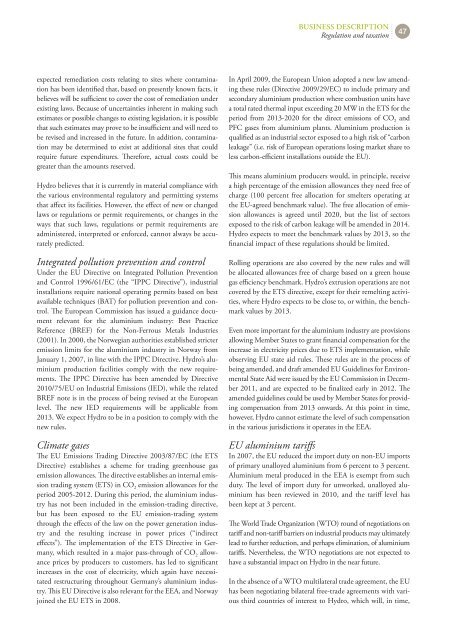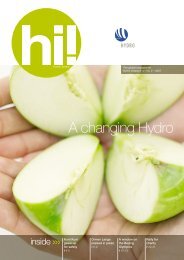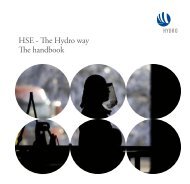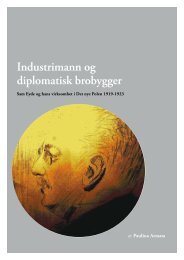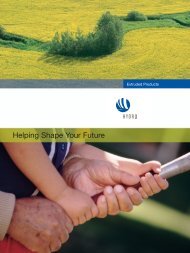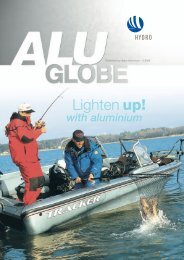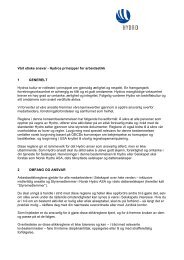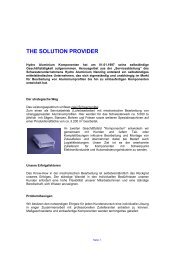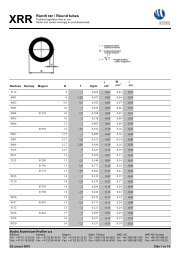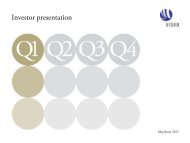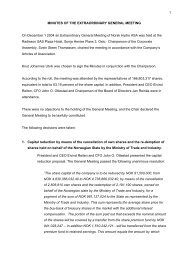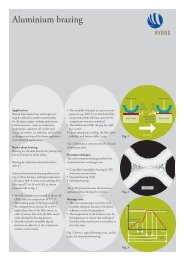Hydro Annual Report 2011b
Hydro Annual Report 2011b
Hydro Annual Report 2011b
Create successful ePaper yourself
Turn your PDF publications into a flip-book with our unique Google optimized e-Paper software.
expected remediation costs relating to sites where contamination<br />
has been identified that, based on presently known facts, it<br />
believes will be sufficient to cover the cost of remediation under<br />
existing laws. Because of uncertainties inherent in making such<br />
estimates or possible changes to existing legislation, it is possible<br />
that such estimates may prove to be insufficient and will need to<br />
be revised and increased in the future. In addition, contamination<br />
may be determined to exist at additional sites that could<br />
require future expenditures. Therefore, actual costs could be<br />
greater than the amounts reserved.<br />
<strong>Hydro</strong> believes that it is currently in material compliance with<br />
the various environmental regulatory and permitting systems<br />
that affect its facilities. However, the effect of new or changed<br />
laws or regulations or permit requirements, or changes in the<br />
ways that such laws, regulations or permit requirements are<br />
administered, interpreted or enforced, cannot always be accurately<br />
predicted.<br />
Integrated pollution prevention and control<br />
Under the EU Directive on Integrated Pollution Prevention<br />
and Control 1996/61/EC (the “IPPC Directive”), industrial<br />
installations require national operating permits based on best<br />
available techniques (BAT) for pollution prevention and control.<br />
The European Commission has issued a guidance document<br />
relevant for the aluminium industry: Best Practice<br />
Reference (BREf) for the Non-ferrous Metals Industries<br />
(2001). In 2000, the Norwegian authorities established stricter<br />
emission limits for the aluminium industry in Norway from<br />
January 1, 2007, in line with the IPPC Directive. <strong>Hydro</strong>’s aluminium<br />
production facilities comply with the new requirements.<br />
The IPPC Directive has been amended by Directive<br />
2010/75/EU on Industrial Emissions (IED), while the related<br />
BREf note is in the process of being revised at the European<br />
level. The new IED requirements will be applicable from<br />
2013. We expect <strong>Hydro</strong> to be in a position to comply with the<br />
new rules.<br />
Climate gases<br />
The EU Emissions Trading Directive 2003/87/EC (the ETS<br />
Directive) establishes a scheme for trading greenhouse gas<br />
emission allowances. The directive establishes an internal emission<br />
trading system (ETS) in CO 2 emission allowances for the<br />
period 2005-2012. During this period, the aluminium industry<br />
has not been included in the emission-trading directive,<br />
but has been exposed to the EU emission-trading system<br />
through the effects of the law on the power generation industry<br />
and the resulting increase in power prices (“indirect<br />
effects”). The implementation of the ETS Directive in Germany,<br />
which resulted in a major pass-through of CO 2 allowance<br />
prices by producers to customers, has led to significant<br />
increases in the cost of electricity, which again have necessitated<br />
restructuring throughout Germany’s aluminium industry.<br />
This EU Directive is also relevant for the EEA, and Norway<br />
joined the EU ETS in 2008.<br />
BusIness DesCrIptIon<br />
Regulation and taxation<br />
47<br />
In April 2009, the European Union adopted a new law amending<br />
these rules (Directive 2009/29/EC) to include primary and<br />
secondary aluminium production where combustion units have<br />
a total rated thermal input exceeding 20 MW in the ETS for the<br />
period from 2013-2020 for the direct emissions of CO 2 and<br />
PfC gases from aluminium plants. Aluminium production is<br />
qualified as an industrial sector exposed to a high risk of “carbon<br />
leakage” (i.e. risk of European operations losing market share to<br />
less carbon-efficient installations outside the EU).<br />
This means aluminium producers would, in principle, receive<br />
a high percentage of the emission allowances they need free of<br />
charge (100 percent free allocation for smelters operating at<br />
the EU-agreed benchmark value). The free allocation of emission<br />
allowances is agreed until 2020, but the list of sectors<br />
exposed to the risk of carbon leakage will be amended in 2014.<br />
<strong>Hydro</strong> expects to meet the benchmark values by 2013, so the<br />
financial impact of these regulations should be limited.<br />
Rolling operations are also covered by the new rules and will<br />
be allocated allowances free of charge based on a green house<br />
gas efficiency benchmark. <strong>Hydro</strong>’s extrusion operations are not<br />
covered by the ETS directive, except for their remelting activities,<br />
where <strong>Hydro</strong> expects to be close to, or within, the benchmark<br />
values by 2013.<br />
Even more important for the aluminium industry are provisions<br />
allowing Member States to grant financial compensation for the<br />
increase in electricity prices due to ETS implementation, while<br />
observing EU state aid rules. These rules are in the process of<br />
being amended, and draft amended EU Guidelines for Environmental<br />
State Aid were issued by the EU Commission in December<br />
2011, and are expected to be finalized early in 2012. The<br />
amended guidelines could be used by Member States for providing<br />
compensation from 2013 onwards. At this point in time,<br />
however, <strong>Hydro</strong> cannot estimate the level of such compensation<br />
in the various jurisdictions it operates in the EEA.<br />
EU aluminium tariffs<br />
In 2007, the EU reduced the import duty on non-EU imports<br />
of primary unalloyed aluminium from 6 percent to 3 percent.<br />
Aluminium metal produced in the EEA is exempt from such<br />
duty. The level of import duty for unworked, unalloyed aluminium<br />
has been reviewed in 2010, and the tariff level has<br />
been kept at 3 percent.<br />
The World Trade Organization (WTO) round of negotiations on<br />
tariff and non-tariff barriers on industrial products may ultimately<br />
lead to further reduction, and perhaps elimination, of aluminium<br />
tariffs. Nevertheless, the WTO negotiations are not expected to<br />
have a substantial impact on <strong>Hydro</strong> in the near future.<br />
In the absence of a WTO multilateral trade agreement, the EU<br />
has been negotiating bilateral free-trade agreements with various<br />
third countries of interest to <strong>Hydro</strong>, which will, in time,


